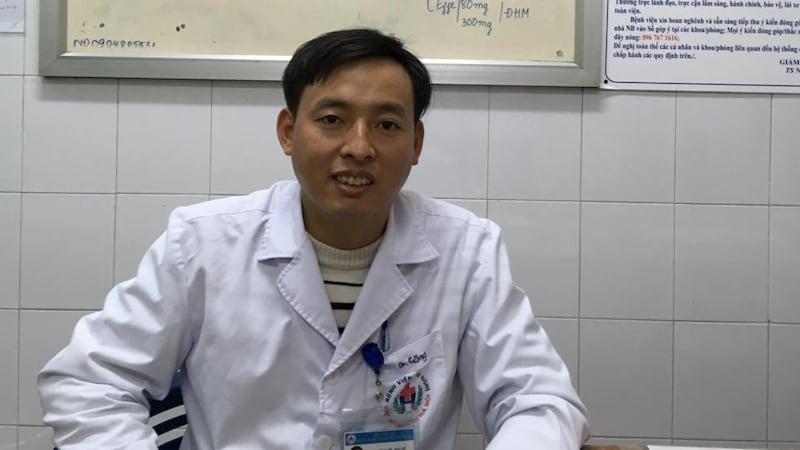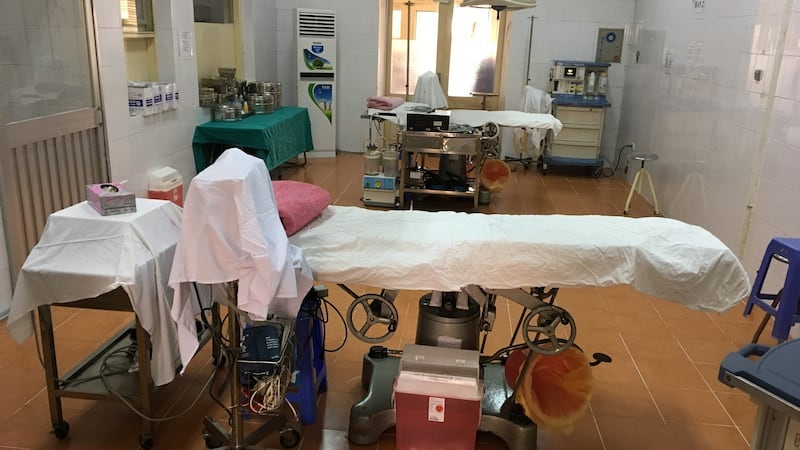There are more disabled people in Vietnam than there are people in the Republic of Ireland – upwards of five million, according to Irish Aid. Over the past 25 years, economic liberalisation has turned what was one of the world's poorest countries into a regional powerhouse with a growing middle class. Yet the scars of its past remain.
April 30th, 2017 was the 42nd anniversary of the Fall of Saigon, marking the victory of Communist forces in the Vietnam War after more than a decade of bloodshed. Images of the US evacuation and the ensuing bloodbath of thousands of South Vietnamese “collaborators” are now a fading from collective memory, but the American War continues to loom large. In some areas, it’s still claiming casualties.
During the war, Vietnam played host to 2.7 million US soldiers. But more than four decades on, one guest continues to outstay its welcome: Agent Orange.
Vietnam has an estimated 1.3 million disabled children
Agent Orange is a chemical weapon is a mixture of dichlorophenoxyacetic acid and trichlorophenoxyacetic acid (2,4,5-T), first used extensively by the British in Malaya. In Vietnam it acted as a herbicide and defoliant, robbing local guerrilla groups such as the Viet Cong of jungle cover.
Between 1962 and 1971, the United States sprayed 12 million gallons of Agent Orange across the South Vietnamese countryside.
As well as turning forests the size of Munster into toxic landscapes, Agent Orange also contained a poisonous dioxin, for which there is no treatment. It quickly seeped into the agricultural food chains, and continues to contaminate swathes of the country.
Birth defects
The Vietnamese government, and many international observers, blame the severe genetic birth defects that have afflicted three generations of Vietnamese people on aerial and ground spraying to this day.
Local advocates claim that three million to four million people have been affected by the chemical, including hundreds of thousands who have died from the dioxin. It has also allegedly led to a high prevalence of congenital deformities. In 2008, the US Fund for Unicef admitted as much, noting Vietnam's "disproportionately large number of disabled children – including many affected by exposure to chemicals left over from the spraying of Agent Orange".
While the scientific link is by no means proven, Vietnam has an estimated 1.3 million disabled children and a particularly high prevalence of cleft palate or cleft lip – a gap in the mouth that fails to close during the early stages of pregnancy. Internationally, about one in every 500 live births result in a cleft. In Vietnam, according to NGOs and doctors on the ground, the rate is closer to one in 50, or 2 per cent of all births, although hard World Health Organisation data is lacking.
Today, thousands of modern cars and mopeds stream down Hanoi's Hai Ba Trung Street, a mark of how lightly Vietnam now wears its red flag. On the street, just south of the picturesque, smog-swaddled Ho Hoan Kiem lake, lies the Vietnam-Cuba Friendship Hospital, a relic of a time when Cuba was a relatively stable economic entity, and Vietnam its poor communist relation.
Based in a French colonial building, with large deciduous trees sheltering rows of mopeds inside its courtyard, “The Cuba” has an air of faded grandeur and of languorous, unhurried elegance. Yet occasionally it is abuzz with hundreds of families.
Operation Smile
For the past 20 years, The Cuba has hosted "missions" for children with cleft conditions, funded by Operation Smile, an NGO with its headquarters in Virginia and offices in Dublin (operationsmile.ie).
One doctor at the Cuba, Do Van Cong, leads a team that has operated on 600 children with cleft conditions this year alone. He calls it a relatively simple procedure, lasting from 45 minutes to a few hours. Patients, mostly children, usually leave the following day if there are no complications. Yet not all patients are children.

“I recently had a patient who is 60 years old,” he says. “He had both cleft lip and cleft palate. He had a difficult life. When he came here he wanted surgery, but he didn’t even know the meaning of cleft lip and cleft palate. He just heard people tell him there is free surgery under a programme. He didn’t know he could be fixed; he just always knew there was something different about him.
“Many families, especially in the countryside, still believe that facial deformity is caused by bad luck, or something outside of their control.”
To do more
Each operation costs about $350 (€321). “It’s not a lot,” says Hao Nguyen, programme co-ordinator with Operation Smile. “We want to do more; we want to develop a speech therapy programme. After 18 months, you can fix the cleft palate [six months with cleft lip] and there’s no problem. But if they are two years or older, you need speech therapy afterwards.
“We want to fix it before they are too old,” she says. “They might have problems eating, problems speaking, and psychological problems, social problems. It has a really long-term impact on the community. Parents get an ultrasound and ring up and ask us whether they should have an abortion to prevent a child with a cleft lip. They think it’s something terrible, the end of the world. But it’s very easy to treat.”
Last year Operation Smile provided operations on 2,000 children – the maximum hospital capacity could allow – and played host to a visiting Irish plastic surgeon, Michael Early.
Nguyen welcomes me to the NGO’s office in downtown Hanoi. Trophies and awards deck the room and the walls.
“There are many children born disabled in Vietnam,” she says. “Part of the reason might be from Agent Orange. But most of the reason, I think, is a genetic problem. The healthcare here isn’t very developed either, so if the mother has illness during pregnancy, it could cause problems.”

“People haven’t found the exact reason why children are still being born with facial deformity and cleft palate,” Cong adds. “Maybe there are some environmental and genetic reasons. Nevertheless, there is still a 2 per cent natural percentage of children being born with cleft palate and cleft lip.
“There are still people in remote areas who are still suffering from Agent Orange. They are the children, the grandchildren and the great-grandchildren of the victims of the war. But we haven’t had enough research on the link.”
Surgical backlog
Back in Hanoi, the backlog of patients awaiting surgery for cleft palate and lip conditions is increasing.
“Some people come to us who have a family history of suffering from the after-effects of Agent Orange,” says Bei Nguyen. “Many children were left with cleft lip and cleft palate problems after the war.
“We thought after a few years of our work, the backlog would decrease. But it has increased. This could be down to more people becoming aware of it, or it could be down to new environmental effects. The food may not be healthy.”
With a birthrate of about 1.6 million a year, six or seven babies a day are born with cleft lip or palate condition.
Late last October in Hoa Binh, about 100km southwest of Hanoi towards the Cambodian border, Hao Bo Tram gave birth to Bui Bo Tram. She was born with a bilateral cleft lip and palate prompting, in her mother’s mind, fears of bad karma or luck.
The baby seemed destined for a life of pain and stigma, as her mother explains through a translator.
“Right after giving birth to this baby, the burden of my life seemed so hard, so difficult,” she says. “Tram was born with bilateral cleft lip and palate, so she had difficulty in eating and drinking. Also, she usually had ear-nose-throat problems and got sick.
“My baby and I spent almost the whole time staying at home. Sometimes in my mind, I thought maybe she was bad luck we had to receive in this life because we did something wrong and terrible in the previous life.
“I felt unconfident and shy whenever bringing my baby outside. I was scared of strangers’ eyes.”
Medical lifeline
Twenty years ago, that would have been their lot, but the advent of Operation Smile, and the ongoing training of local doctors, has given a lifeline to less well-off families. On April 20th, Cong and his team operated on Bui in Cuba Hospital, just another of the thousands of patients they have helped transform.
“No words can describe the feeling after the operation, apart from maybe happiness and luck,” Hao says. “I wanted her to have a normal life like others. Now I have a confidence in bringing her outside and see how life is going on. A life-changing smile is a significant turning point –not only in my baby’s life but also in my family’s.”
She becomes tearful when speaking of the transformative effects.
“At first, holding her in my arms with the new smile, my tears was running, my heart beating hard. I felt moved, I felt strange but close. She was familiar but difficult to recognise. And her smile is now similar to other babies.
“I feel a miracle has come to us. Luckier, and more honoured is my family. From the bottom of my heart, and on behalf of lots of other mothers, I would like to give our great gratitude to the charities, donors and especially medical professors who have donated the lost smiles to our beloved babies.”
PANEL: AGENT ORANGE – WHAT THE RESEARCH SAYS
To establish the reasons behind the high prevalence of cleft palate, Operation Smile is taking part in an international family study with the Institute for Global Health.
Some previous studies – including one undertaken by Prof Nguyen Viet Nhan in Hue – show a large prevalence of multiple physical abnormalities (including cleft palate), and mental disabilities in areas affected by Agent Orange.
Internationally, however, there is a huge vested interest in preventing the establishment of a clear link between genetic physical abnormalities and the spraying of Agent Orange. In recent years, US courts have dismissed a suit from Vietnamese victims against the chemical corporations that manufactured the herbicides sprayed during the Vietnam War.
Since 1991, the US has provided benefits to American veterans suffering from cancer and diabetes as a result of their contamination, but not to Vietnamese victims. Hanoi has called on the United States – now its largest trading partner – to do more to compensate an estimated three to four million victims.
Some US senators have admitted a causal link between those victims’ disabilities and Agent Orange.
Under the Obama administration, USAid began contributing to the clean-up of contamination in Vietnam, beginning in 2012, at Da Nang airport. Until recently, a contaminated lake was still being used here for fishing.
Local groups point out that the US has spent $50 million on searching for the remains of its soldiers in Vietnam, but allocated just $6 million since 2007 to help address Agent Orange contamination.
* This article was supported by a grant from the Simon Cumbers Media Fund


















